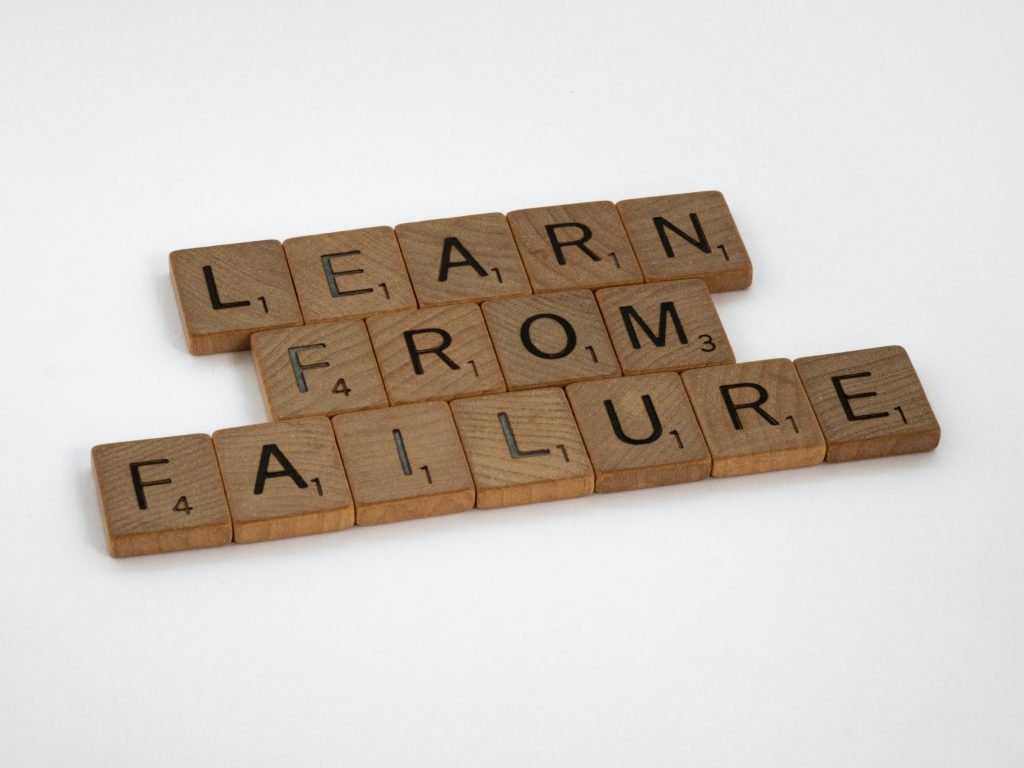Failure anxiety is a killer. Because it restrains yourself from taking steps that could take you much further. Much further in relationships, in your career, in school or even in personal goals. You may know that failures are allowed, and even be in a culture where failures are allowed but still experience failure anxiety.
Your thinking, your body language and the difficulty of the challenge ahead may all influence the level of failure anxiety you are experiencing. In this article, I will dive into several theories and ways how you could capture failure anxiety, and deal with socially or intellectually challenging situations better.
Let’s dive in the first foundation, the ABCDE model!
(If you are dealing with serious fears, and anxiety, always consult a medical professional. This article is not written to be a professional medical advice).
The ABCDE model

It’s perfectly normal to be afraid as humans, but sometimes this fear is irrational. It is remarkable that some are not afraid to do certain things, while for others it is a whole lot harder. And a whole lot more fearsome.
The way we develop either calm or anxious behavior is grounded in the ABCDE model. This is an abbreviation that explains the following:
- Activating Event: This is something that happens from the outside and makes us feel or think in a certain way.
- Belief: These are our automatic thoughts about what happened, about ourselves, and about other people.
- Consequence: This is how we react emotionally or how we behave based on our beliefs.
- Dispute: This means questioning or challenging those beliefs.
- Effective Behavior: When we successfully resist or change our behavior by challenging our irrational beliefs.
The ABCDE model is one of the corner stones of rational emotive behavioral therapy (RET or REBT), which is part of cognitive behavioral therapy. The idea behind this theory is that the majority if our psychological problems originate from the irrational, odd beliefs we held dear. Beliefs we often encountered in other situations that may relate to the current problems, but are actually vastly different.
The great thing is that we are capable to change or irrational beliefs, and with that our thinking, feelings and even behavior. This is also reflected in the model for the letters D and E.
Let’s give an example:
- Activating event: There’s a dog coming at you
- Belief: Oh dear, there is a dangerous dog coming
- Consequence: You’re getting afraid, your legs are going to shake and you’re frozen.
- Dispute: But is this dog dangerous after all? His boss is near and he’s on the leash.
- Effective behavior: There’s no danger, what am I worried about. I can continue what I was doing.
In the above example, it must be noted that the believe may of course originate from earlier bad experiences with dogs, which may make the behavior more rational. However, in many cases our beliefs are not so rational.
If you want to conquer fear, you have to challenge your irrational thoughts and examine if the belief is really true, or if it is wrong. You have to change your fearful thoughts in less fearful thoughts, which in turn will affect your feelings and behavior.
As a simple exercise, try doing the following after a certain event:
- Which kind of thoughts would make me more fearful?
- Which kind of thoughts would make me more calm?
- Is what I am thinking realistic?
In many cases, you would discover that what you think is not realistic after all, and in reality the outcome of a certain event would be much better. Typically, two types of thoughts make people more anxious:
- Thoughts where a very high demand is placed on one self, often phrased by “I have to” (which is also the root of many drivers). Setting too high standards lowers self confidence, which in turns increases anxiety. Standards itself are not bad, but they should be realistic.
- Any thoughts in which the negative consequences of an event are greatly exaggerated. An exemplary thought is “This is terrible, I will be fired and I will lose everything” after making a small mistake at work.
The power of the ABCDE model is that it focuses on the thinking before behavior, instead of trying to change the behavior itself. Forcing to change the behavior often doesn’t work, but changing the thinking behind it will often change the behavior itself.
Below are some examples of what you may think in your anxiety, and how this thinking could be changed in calmer thinking:
- Anxious thought: I have to do well
- Calm thought: My life does not depend on it
- Anxious thought: I am not going to make it, I will never finish my work
- Calm thought: I will continue working and see when it will be done
- Anxious thought: O dear, they are all looking at me.
- Calm thought: Let them look, when they are talking, I am also looking right?
- Anxious thought: I failed again
- Calm thought: I will be able to succeed, every time I can try again
Lowering fear: Getting more relaxed

Anxiety is not only an emotion, but it is connected to the body and the body posture. As a consequence, failure anxiety can result in headaches, fatigue and insomnia. But it also works the other way around. If our body is relaxed, we usually experience a lower degree of anxiety.
But how do we get the body in a more relaxed posture? There are a few things you could do:
- Taking a hot shower or spa
- Exercising or doing a sport, such as running or a workout
- Doing relaxation exercises or meditations.
Here’s an example of a relaxation exercise:
- Look for a quiet place, and seat yourself in a comfortable chair.
- Lean a bit backwards in this chair.
- Kick your legs for a bit and afterwards, place them flat on the ground
- Shake your arms vigorously, and let them subsequently rest on the armrests.
- Close your eyes
- Turn your head a few rounds in a big circle, and then let it rest
- If you feel any tight muscles in your body, tense these muscles for a few seconds and let them relax afterwards.
- Breath slowly and deeply. Inhale through your nose, and exhale through your mouth (you will then be using your stomach for breathing, which is important for relaxation. You should feel your stomach going up and down).
- Breath in, count to three, and slowly exhale. Do this for a few minutes.
- If everything goes well, you should feel more relaxed now.
If you only have a short time to become more relaxed, you could do the following.
- Stand or sit straight, putting your shoulders back.
- Let your arms hang loose
- Place your feet slightly wider than shoulder width flat on the ground
- Breathe slowly in through your nose, and exhale through your mouth.
This is a very useful technique that can be used just before meetings, presentations or any challenging moment.
Conquering failure anxiety in school or work

Now that we talked about some theory and some relaxation, it’s good to discuss some practical tips that may be helpful when dealing with failure anxiety at school or work.
In preparation (of school or work)
Oddly enough, a lot of tips to conquer your fear are about bringing structure and rest in your schedule. You are responsible for your own planning, both in your professional or school life, as your personal life. Maintaining a realistic schedule will help you a great deal,lower your fears and in the end also help you to achieve more.
- Be sure to plan your homework or work projects, especially for bigger assignments or projects.
- Keep a buffer in your agenda. It’s good to be challenged by activities outside work or school, but you should have time to wind down. You can even block this time in your agenda.
- It’s good to work hard, but it should not be stressful. It’s not uncommon (or at least it should be) to have about 10 minutes off every hour. Don’t forget to take frequent breaks, don’t skip lunches and don’t work during lunches. Also try to avoid late night work, but wind down during the evening so you will go to bed much more relaxed.
- For school work, it’s better to first complete your usual schoolwork, and then focus on learning for your exams or tests. It’s mentally a lot better if you’ve already completed your homework and then can focus on just the exams or tests.
- For learning (either in school or for work), focus on understanding, not on remembering. Understanding is achieved by repeating knowledge, explaining it to others, by doing exercises, and by trying to solve the challenge first, before asking help.
- Set realistic goals and ambitions. Just do your best and see your goals as learning goals, not as performance goals (in the end, a lot of things are about learning, and not about performance).
- When your (home)work is finished, take some time off, and then look at it one time again. You’ll be looking at it with a fresh mind, probably discover some mistakes and be more confident in your work.
- Ask help from an outsider, such as a colleague or parent to help you with the above tips.
- Do the earlier mentioned relaxation exercises.
While going to school or work
Here are some tips while being at school or work:
- Be conscious of your thinking (remember the ABCDE model), and whether your thoughts are calm or fearful, and realistic.
- Never let others you make rush your work, or make you more nervous. If the people around you are only making you more anxious or nervous, indicate this, or if possible take some rest in a more calm environment
- Try to keep your posture and breathing relaxed.
- Always ask questions, and think before you ask questions about whom you are asking, and what you want to achieve by asking this questions.
- Start with the hardest tasks, questions or work, and finish with the easier ones (whether it’s an exam or a work day, this principle applies).
- Don’t try to hastily fix mistakes at the latest moments, whether you are finishing a work project or doing an exam.
- When getting feedback, either on work or on school, think about what went wrong. This will help you to learn from it, and will help you grow.
What if the failure anxiety keeps existing?
It would be important to consider if failure anxiety is triggered internally, or if external factors are triggering the anxiety. Think of a very aggressive or demanding boss, a very strict teacher, or parents that raise the bar. Failure anxiety can also be rooted in past traumas.
Within your working place, university, college or school, there may be specially appointed persons or therapists who can help you dealing with failure anxiety. Also do not hesitate to consult a medical professional, a doctor or a professional therapist to help you deal with persisting failure anxiety.
Dealing with Children that have Failure Anxiety

Finally, you may not be the person with failure anxiety. Maybe you have colleagues, schoolmates, relations or children with failure anxiety. In this section I want to share a few tips for dealing with children that have failure anxiety.
As a parent, it’s very important that a child is taken seriously – not to seriously by demanding a lot from the child, but also not ignoring the struggles that a child isAnd remember going through.
Children that encounter failure anxiety often have some characteristics that you can take into account as a a parent:
- Children with failure anxiety have the need for a pleasant atmosphere, both at home as at school. An atmosphere where failures are possible, where they are accepted and notlearn-to-relax.jpg being laughed at. Don’t compare your child with other children that are doing better, accept the child unconditional of performance. As a parent you should know that everyone make mistakes.
- Children with failure anxiety need realistic, positive expectations. Don’t overestimate, but also do not underestimate children. Have positive expectations that the child can meet (which also requires you, as a parent, to know your child and spend time with the child). It’s good to challenge a child at it’s own level.
- Children with failure anxiety need structure, overview and clarity, more than regular children. Children need to know where you stand, what is expected, and what can be expected. Make clear agreements with the children, and cut tasks that need to be done in smaller, less complex tasks.
- Children with failure anxiety need honest feedback on their own performance. Usually, children with failure anxiety need more confirmation, encouraging and feedback, using compliments, pats on the back and so forth. When giving positive feedback, be specific in what they did well. When giving negative feedback, never criticize the child itself, but criticize what went wrong in the task at hand. Also explain a way out, or how to solution for the given task can be found. Never say things like: “You’re never able to learn this.” Feedback would be rather structured as the following: “Hey, I can see you’re already very good in your English grammar, but let’s review some of the chapters for History because I think some dates are of.” Depending on the confidence of the child, feedback could grow from more specific to more general, as a child will be able to find out more things by itself.
- Children with failure anxiety tend to attribute their success to external factors such as chance or luck, while they attribute failure to themselves. As parents, clarify to your children that their success is also because of their own efforts.
- Children with failure anxiety have a negative pattern of thinking when they need to perform. Some examples are “I cannot do this”, “It will fail again”, “I will always fail”. The consequence of this thinking often reveals itself in physical complaints, such as faster breathing, tense muscles, sweaty hands, headaches, stomach ache, nausea, and so forth). It’s helpful to teach children the ABCDE model, or at least help them to think more positively (and remember to be realistic as well)
A child that is insecure may often come with a lot of questions. While it is tempting to give the answer, it is better to learn the child how it can find the answer himself. A child learns from mistakes, and when there is an atmosphere where mistakes can be made (and can be learned from), a child will grow self confidence.
Let’s Conquer Failure Anxiety!
So, that was quite a read! I hope I have not failed in writing too elaborate, for which I was a bit afraid (pun intended). Let’s do a small recap.
In this article, I looked at the ABCDE method (from Rational Emotive Therapy) which helps conquering failure anxiety by restructuring your thoughts. I also what you can do to make your body more relaxed, how to deal with anxiety in a school or work setting and some practical tips for social situations, and finally some tips parents with children that encounter failure anxiety.
I hope these tips help you to live with courage, have realistic fears, and be more relaxed!